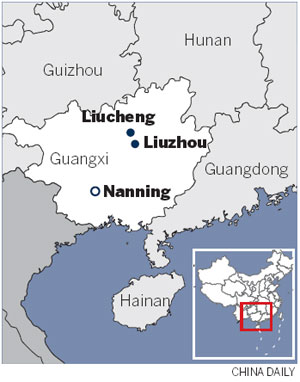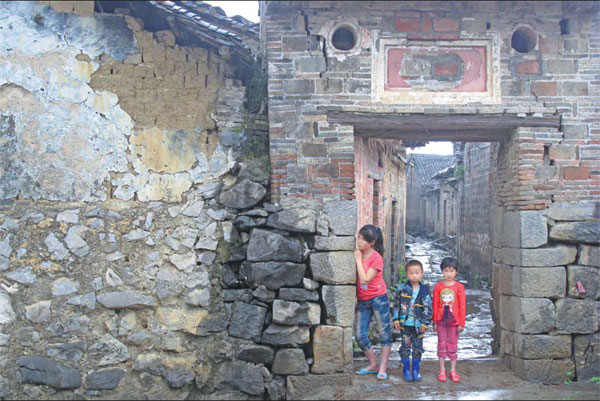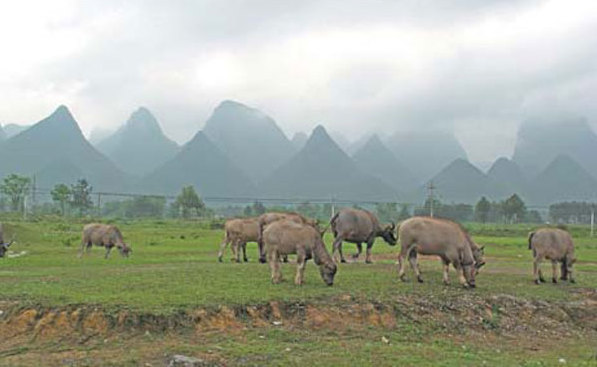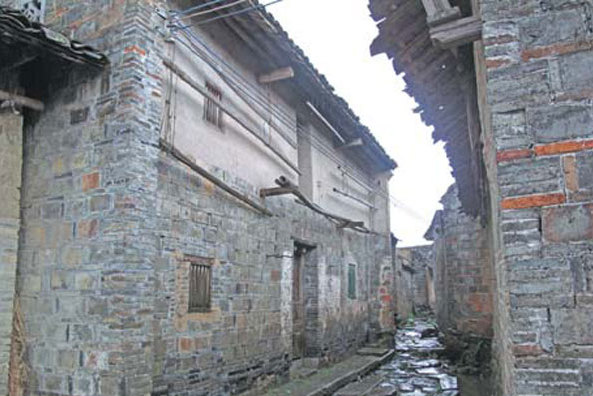Village that time forgot
Updated: 2013-05-16 05:07
By Li Yang (China Daily)
|
||||||||
|
The main residents in Pancun village are children and the elderly, while the young and middle-aged work in cities. Photos by Li Yang / China Daily |
|
Pancun village is a fertile place surrounded by rolling mountains. |
|
Pancun's labyrinth-like lanes are hard for strangers to navigate. The village has been home to the Mulam people for more than 800 years. |
Pancun village has been left unspoiled by modern life, giving visitors a rare glimpse into life as it was lived in a different time. Li Yang reports in Liucheng, Guangxi Zhuang autonomous region.
Pancun village is so well-preserved that visitors can easily lose themselves in the rich history of the site. Time is frozen here. Political slogans from the "cultural revolution" (1966-76) painted on the walls some 40 years ago are still clearly visible. The wet, slippery, labyrinth-like lanes, moss-covered stone walls and timeworn wooden sculptures make it distinct from other old villages in China. The deathly stillness, tightly shut, shabby wooden doors and empty lanes reinforce the feeling that I am not welcome in such a special old place.
I visited the village of the Mulam people, an ethnic group in Liucheng of the Guangxi Zhuang autonomous region, on a rainy afternoon in May.
The only sign of life was the rainwater dripping down from the black earthen tiles and the water flowing along the open gutters on both sides of the lanes, built in the late Song Dynasty (960-1279).
Occasionally, piles of fresh cow dung in the middle of the narrow lanes reminded me that buffaloes still roam this seemingly deserted village.
The village has 120 families, making up some 700 residents. About 150 old villagers and 50 children live in the village now. The other young and middle-aged villagers work in Guangdong province and only return for important festivals.
According to Pan Liuquan, the village's Party chief, the villagers have maintained their way of life for hundreds of years. They have a self-sufficient existence - planting grain, pickling food and weaving and dying their own clothes.
Pan led me into an ancestral temple in the center of the village. It is a three-story gray-brick building that dwarfs the other houses. It boasts a large central yard for important clan gatherings. In the main hall stone tablets are inscribed with characters recording how the village was formed.

The ancestors of current inhabitants, a Mulam family named Pan, fled to the mountains in northern Guangxi from Wuxi in Jiangsu province late in the Song Dynasty to avoid the Mongolian invaders.
When they reached the site of the village, they thought it was an auspicious place to settle down. They found coal in the valley, which could be used for heating, and there was a brook flowing at the foot of the mountains.
The river provided them with enough water and there was a patch of fertile land - rare in mountainous areas. They named the patch of land "dragon boat land", as they firmly believed the God of heaven guided their way here.
The Pan family cultivated small patches of land in valleys and planted rice, sweet potato, sugarcane, corn and mushrooms. The village gradually prospered into a place with hundreds of people.
They made their new homes easy to defend and difficult to attack. The village, encircled by a tall gabled wall, looks like a small castle from the outside, with watchtowers and gates facing different directions.
They also built an inner-village, which was encircled by tall buildings. If the outer defense line was broken, the villagers could withdraw to the inner-village, equipped with a grain depot and water cellar.
The villagers could live on the food and water stored there for about 100 days.
The labyrinth-like lanes made it easy for local people to flee and hard for strangers to navigate.
The lanes are 1 to 2 meters wide and equipped with the original open-gutter drainage system dating back to the Song Dynasty. About 50 cm deep and 50 cm wide, the gutters divert the mountain torrents and flooding rains to the paddy field outside the village.
Thanks to the reliable drainage system, the village has not been flooded for nearly 800 years.
The villagers pay special attention to protecting the gutters.
Deng Cheyi, a local villager says: "We are taught from childhood not to throw anything into the gutters. In fact, we did not have so much rubbish before. Cow dung is the only thing you can find in the gutters. But when the flood comes, the dung will be washed to the paddy fields as valuable fertilizer."
Kaitang Festival in November and Yifan Festival in winter, held every three to five years, are the two most important festivals for the Mulam ethnic group in the village.
The villagers offer sacrifices of thanksgiving for God's protection.
The tribal heads of the village are responsible for practicing festival rituals and etiquette.
Most young Mulam people from Pancun working in cities do not know how to speak the Mulam language, let alone the rituals and songs of the ethnic group.
Long Guangli, a 70-year-old villager, says he is concerned about their disappearing culture.
"When the old people die, the language, songs, rituals and crafts of weaving Mulam cloth will disappear. Nobody bothers to learn it now," he says.
Next to the old village stand rows of new houses built with red bricks and red tiles, which contrast sharply with the time-honored old village.
Pan Liuquan says the young migrant workers send money home and choose to build new houses there. But most old residents prefer to live in the old village.
Local officials say they are inviting investors from around China to develop the old village into a tourist attraction. I am lucky to see the village's original state before its commercial development.
In the future, the old village and its old residents may only exist in people's memories.
Contact the writer at liyang@chinadaily.com.cn.
(China Daily 05/16/2013 page19)

 Michelle lays roses at site along Berlin Wall
Michelle lays roses at site along Berlin Wall
 Historic space lecture in Tiangong-1 commences
Historic space lecture in Tiangong-1 commences
 'Sopranos' Star James Gandolfini dead at 51
'Sopranos' Star James Gandolfini dead at 51
 UN: Number of refugees hits 18-year high
UN: Number of refugees hits 18-year high
 Slide: Jet exercises from aircraft carrier
Slide: Jet exercises from aircraft carrier
 Talks establish fishery hotline
Talks establish fishery hotline
 Foreign buyers eye Chinese drones
Foreign buyers eye Chinese drones
 UN chief hails China's peacekeepers
UN chief hails China's peacekeepers
Most Viewed
Editor's Picks

|

|

|

|

|

|
Today's Top News
Shenzhou X astronaut gives lecture today
US told to reassess duties on Chinese paper
Chinese seek greater share of satellite market
Russia rejects Obama's nuke cut proposal
US immigration bill sees Senate breakthrough
Brazilian cities revoke fare hikes
Moody's warns on China's local govt debt
Air quality in major cities drops in May
US Weekly

|

|










